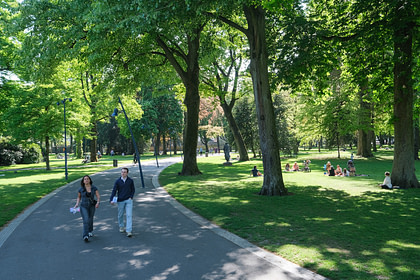

1991 - 1996
Binnenstad Breda
1991 - 1996
Binnenstad Breda
In the 1990s, renewed attention was focused on city centres – a welcome development after decades in which attention had been concentrated on designing urban expansion areas and rehabilitating nineteenth-century urban districts. Numerous cities suffered from a worn-out appearance and a lack of identity: the 30 x 30 cm concrete paving stone from the 1970s, for example, no longer fulfilled aesthetic requirements. In Breda, Bureau B+B worked on a new concept for the centre’s shopping district and the renovation of Valkenberg Park, two large-scale projects that formed part of the structural plan for the city centre adopted by the municipality in 1992.
Breda
Gemeente Breda
30 ha


Bureau B+B, now armed with substantial experience with city centres, wrote in 1995: ‘There is always one central question: What are the city’s qualities and how can these be strengthened? And at the same time, it must be borne in mind that it is not the task of the city to respond well to whatever treatment one applies to it, but rather, that the designer must be willing to do something that the city is up to.’ For the shopping apparatus, the designers took as their point of departure the ambience of a historic town with the convivial and hospitable character typical of the Netherlands’ southern provinces. While a pavement with Dutch clinkers was the solution selected for Hilversum’s sandy ground, in Breda the atmosphere was underscored through the consistent use of robust granite and bluestone in muted grey hues, as a way of reducing the visual agitation of the street scene. The city’s Great Square was relieved of its parking functions and paved with natural stone. On Tuesdays and Fridays, the square is filled with market stalls; the other days of the week, it is characterized by a splendid emptiness, with the square’s smooth surface giving support to the visual impact of the surrounding historic buildings. Following the facelift, the shopping public remained in the city centre for longer periods than it had previously.

‘There is always one central question: What are the city’s qualities and how can these be strengthened? And at the same time, it must be borne in mind that it is not the task of the city to respond well to whatever treatment one applies to it, but rather, that the designer must be willing to do something that the city is up to.’




